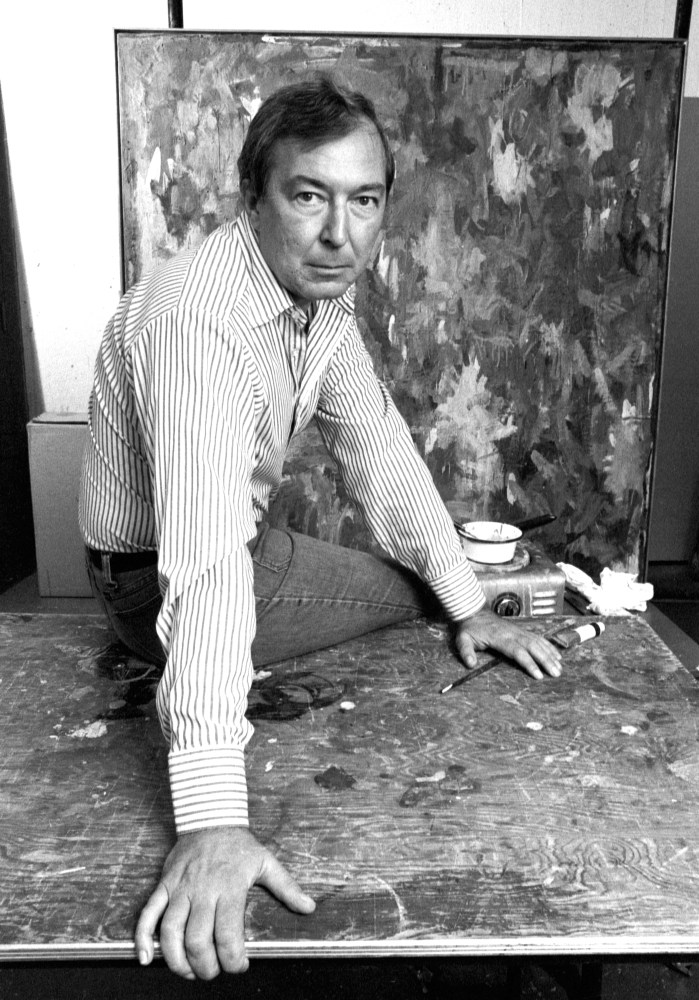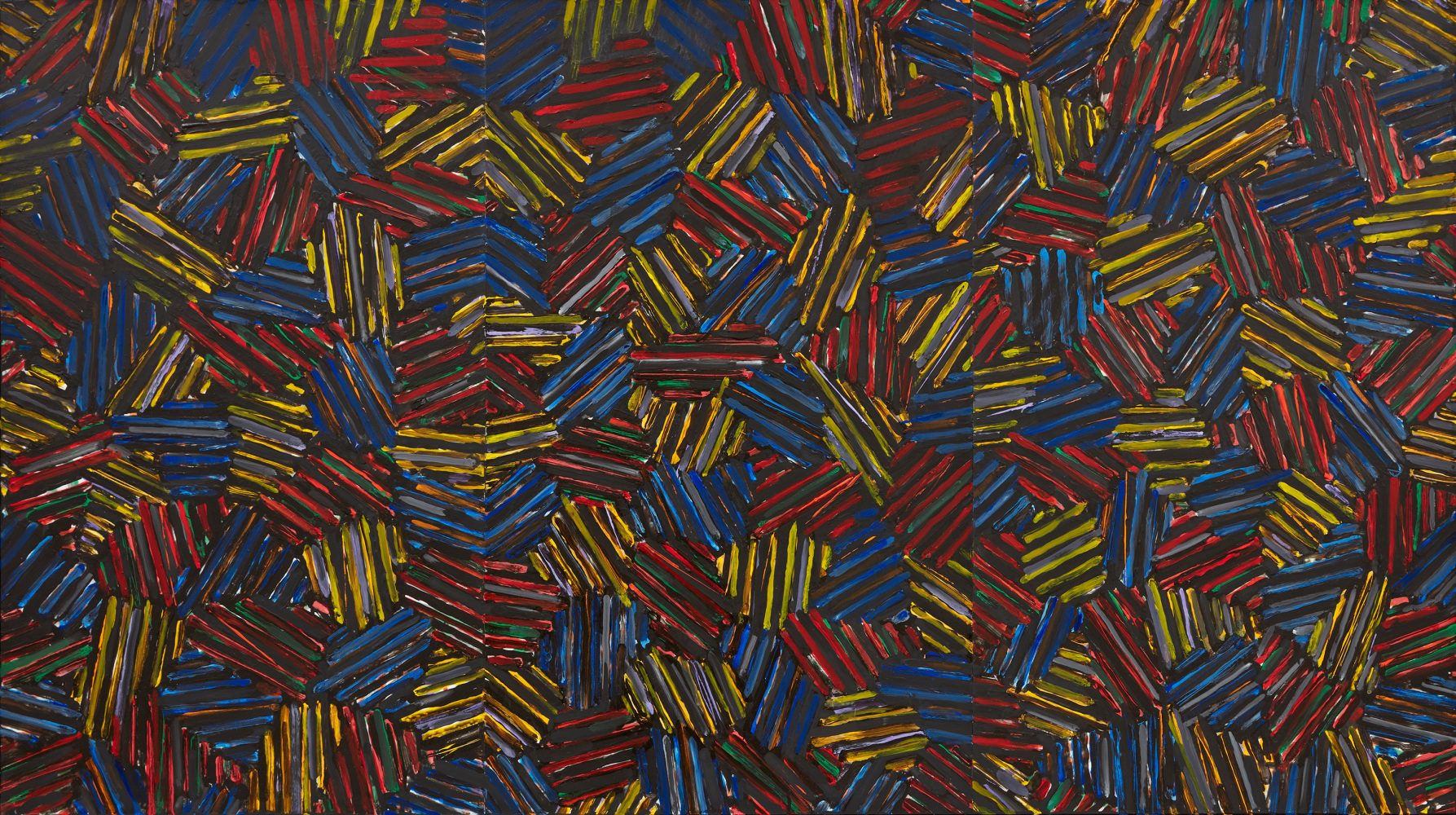Born 1930, August, Georgia
Jasper Johns
Untitled, 1980
Jasper Johns

Portrait of Jasper Johns, New York, 1977.
Photo by Jack Mitchell / Getty Images.
Jasper Johns (b. 1930) is widely regarded as one of the most influential American artists of the twentieth century, whose conceptual and stylistic developments paved the way from Abstract Expressionism to nearly all the artistic movements that followed, setting the stage for Pop Art, Conceptual Art, and postmodernism. Over his storied career spanning the past seven decades, Johns has continued to explore the power of symbols and has developed a nuanced personal lexicon that is both playful and enigmatic. With an intense fascination with semiotics, Johns integrates abstraction with representation while exploring the act of perception, investigating how we see and interpret the world. Along with fellow Neo-Dada pioneer Robert Rauschenberg, Johns has drawn from everyday life to explore the themes of artmaking and art history, autobiography, philosophical engagement, and the act of seeing itself.
Born in Augusta, Georgia, Johns spent his childhood in South Carolina. He briefly attended the University of South Carolina and the Parsons School of Design in New York before serving in the US Army during the Korean War. After returning to New York in 1953, Johns formed a close relationship with artist Rauschenberg, both personally and artistically, and was influenced by composer John Cage and choreographer Merce Cunningham. They four of them became immersed in the New York City art scene, developing opinions and exchanging ideas on art.
“I don't want my work to be an exposure of my feelings."
Jasper Johns
Johns emerged as an influential force in the American art world in the mid to late 1950s with his now-iconic images of everyday, familiar subjects—flags, targets, numbers, maps, and letters. He made his breakthrough painting, Flag, in 1954-55, which he painted after having a dream of the American flag. This work inspired a series of flags and targets, which when they were exhibited at the Leo Castelli Gallery in 1958, earned the artist immediate critical acclaim. In these early works, Johns built up his paintings with newspaper collage and dripped encaustic paint, rendering his familiar subjects in a painterly style that recalls the gestural brushwork of Abstract Expressionism, the dominant movement of the time. Though he emulated the painterly style of the New York School, his depiction of banal, concrete subject matter challenged the lofty premises of the movement. Johns painted familiar things, or “things the mind already knows.”
In the mid-1970s, Johns developed a completely new style of painting, filling canvases with all-over colorful patterns of crosshatches. This mid-career development became one of the most important symbols in the artist’s oeuvre, and he delved into variations on these line clusters for a decade. While the technique of crosshatching is traditionally used to create shadows in drawing and printmaking, Johns divorces the motif from its typical function in the service of allover abstraction. Speaking about his inspiration for the crosshatching, Johns attributed the motif to a chance sighting of a car in motion on the highway that he immediately knew would make compelling fodder for his art. “I only saw it for a second, but I knew immediately that I was going to use it. It had all the qualities that interest me—literalness, repetitiveness, an obsessive quality, order with dumbness, and the possibility of a complete lack of meaning…with the possibilities of gesture and the nuances that characterize the material—color, thickness, thinning—a range of shadings that become emotionally interesting.” Johns’ crosshatch markings ironically appropriate the conceptual gestures of Abstract Expressionism, rendering the movement’s characteristically impassioned brushstroke into a pulsating pattern.
In the 1980s and 1990s, Johns’ work took another turn, and he began exploring the work of other artists. Expanding his popular references to include iconic works from art history, Johns appropriated images from masters such as Mattias Grünewald and Pablo Picasso. In addition, he began exploring autobiographical themes, as seen in his cycle of four paintings titled Seasons (1985-86), which present an allegory of the artist’s life and work. In the 1990s, Johns began his “catenary” paintings, likening to the curve to his own lifeline. After spending the majority of his life in New York, today Johns continues to create new work at his home in Sharon, Connecticut and on the island of Saint Martin.
Johns has been the subject of numerous museum exhibitions and retrospectives. Most recently, the dual-venue retrospective, Jasper Johns: Mind/Mirror, was held at the Whitney Museum of American Art in New York and at the Philadelphia Museum of Art from September 2021 through February 2022. In addition to his influential work in painting, Johns is also celebrated for his larger graphic oeuvre; his drawings, etchings, screenprints, and lithographs have been widely exhibited.
Works of art by Jasper Johns are © 2023 Jasper Johns / Licensed by VAGA at Artists Rights Society (ARS), New York.

